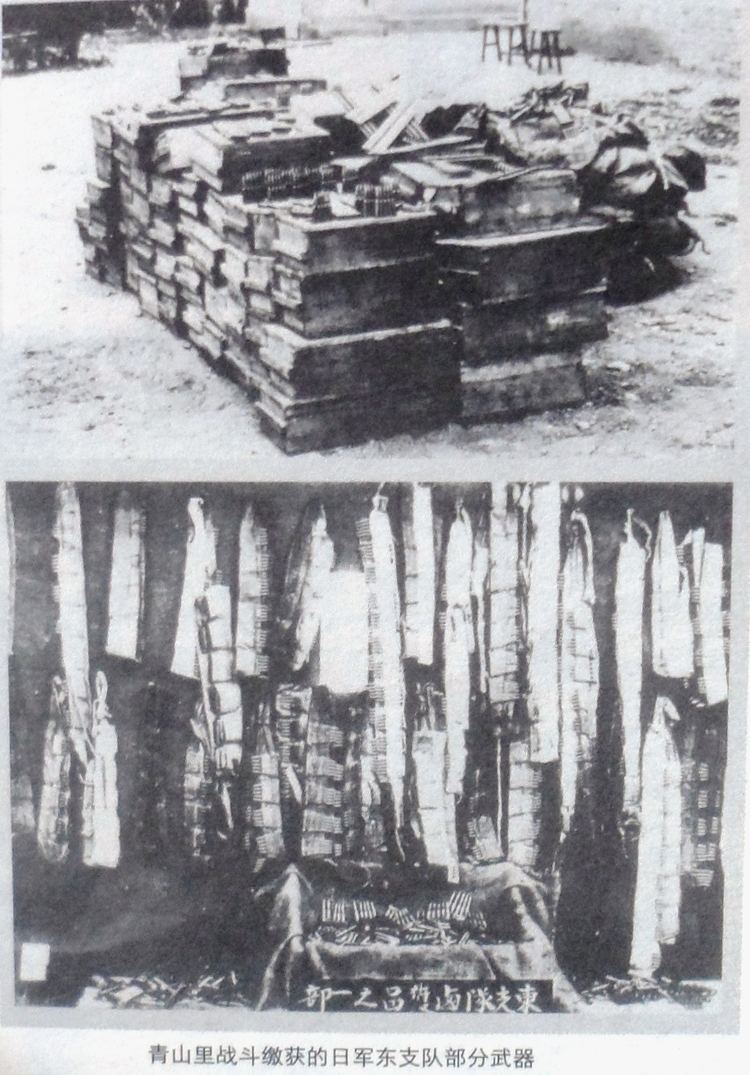About 50,000 about 3,000 | Dates 21 Oct 1920 – 26 Oct 1920 Location Jilin, China | |
 | ||
Tomotake Takashima Masahiko Azuma Naoaki Isobayashi Masuzō Kimura Kim Jwa-jin Lee Beom-seok Hong Beom-do An Mu Japanese record11 killed and 24 woundedKorean record812 ~ 1,200 killed and 2,000 wounded, 200 disappeared 130 killed and 90 wounded Similar Battle of Salsu, Donghak Peasant Revolution, Battle of Pochonbo, United States expeditio, French campaign against K | ||
Battle of qingshanli
The Battle of Qingshanli was fought over six days in October 1920 between the Imperial Japanese Army and Korean armed groups in a densely wooded region of eastern Manchuria called Qīngshānlǐ (Japanese: 青山里, Seizanri; Korean: 청산리, Cheongsanri). It occurred during the campaign of the Japanese army in Jiandao, during the Japanese rule of Korea (1910–1945).
Contents
- Battle of qingshanli
- Background
- Status of the battles
- Hun chun massacre
- Casualties of the Japanese army
- References
Background
After the March 1st Movement of 1919 by Koreans calling for liberation from Japanese occupation, some Korean activists formed an independence army. The Japanese government asked China to subdue them but got no substantive result.
On October 2, 1920, bandits raided Hun-ch'un and killed 13 Japanese including the commissioner of the consulate police. In response, Japan decided to send troops to eastern Manchuria. Japan immediately held talks with China, and on October 16 received permission for military action in eastern Jilin from the governor of Jilin.
Status of the battles
The Japanese forces who joined the expedition were the 28th Brigade of the 19th Division, which was on its way back to Japan, and two units from the 11th and 13th Divisions who had been sent to Vladivostok. Among them, only the 19th Division of the Army launched an actual military operation and the rest contained a lockdown and a demonstration. The 19th Division was deployed to Hunchun (Isobayashi Detachment), Wangqing (Kimura Detachment) and Yanji-Helong (Azuma Detachment). The Isobayashi and Kimura detachments engaged in no major combat.
From October 21 to 23, the Northern military administration office army (Hangul: 북로군정서군; Hanja: 北路軍政署軍) led by Kim Jwa-jin lured some of Japanese soldiers and attacked them in Baiyunping (白雲坪), Quanshuiping (泉水坪) and Wanlougou (完樓溝). Although the Korean force was small and used guerilla warfare, they were victorious. The Japanese force, who were defeated by the Korean Independent Army, appealed for help to the Azuma Detachment. They were rushed in for the relief of the remnants to fight against the Korean Independence Army.
The Azuma Detachment engaged in combat with the Korean Independence Army on October 23. The Northern military administration office army united Korea independent army led by Hong Beom-do in the struggle against Japanese force. The Korean troops had the Japanese Azuma Detachment at a disadvantage, and the two forces fought the final battle in the Yulang town (漁郎村). The Korean army claimed to have killed 1,200 Japanese soldiers, and wounded thousands of others on October 26, though there is little evidence of these figures. As a result of the battle, the Japanese retreated from the area of operation.
Hun-ch'un massacre
South Korea views the Hun-ch'un Incident as a deception by Japan, who they believe used it as an excuse to dispatch troops.
According to Korean sources, the Japanese army bribed a bandit leader named Ch'ang-chiang-hao and made him attack Hun-ch'un. The Japanese victims were incidentally attacked by bandits who were enticed to the raid by Ch'ang-chiang-hao and were not under his control.
Casualties of the Japanese army
Japanese sources claim 11 dead and 24 wounded, and no officer casualties. These numbers are repeated by the list of the dead of the Yasukuni Shrine. Japanese investigation of weapons of the 19th Division after the expedition claims that the Japanese army consumed little.
The only Japanese soldier Korean sources name was "Regimental Commander Kanō." "The Bloody History of the Korean Independence Movement" states that a secret paper by a Japanese consul reported Regimental Commander Kanō's death, although Japan has not revealed such a report so far. Japan claims the only man corresponding to "Regimental Commander Kanō" was Colonel Nobuteru Kanō, who served as commander of the 27th regiment, and that his name cannot be found in the casualty list, but is said to have led the regiment until 1922. Moreover, two months after the Battle of Qingshanli, the regiment commanded by Colonel Kanō captured one Korean. This event is recorded in a secret telegraph from the Japanese consulate in Qingshanli on November 13, 1920.
On the contrary, South Koreans refer to this battle as the "great victory at Cheongsalli" and consider it a victory of the Independence Army. For the casualties of the Japanese army, Chosun Doknip Undongji Hyulsa by Bak Inseok (1920) states "900-1,600 including Regimental Commander Kanō," Daehan Minguk jeongdangsa compiled by the National Election Commission (1964) "over 1,000," Hanguk jeonjaengsa by the Military History Compilation Committee of the Ministry of National Defense (1967) "3,300 dead and wounded," and Hanguk Minjok Undongsa by Jo Jihun (1975) "3,300 including Regimental Commander Kanō."
